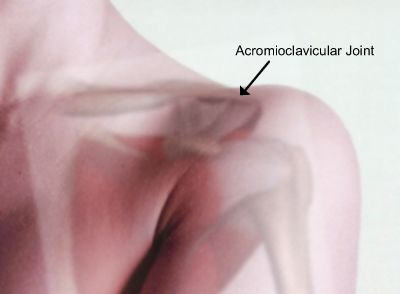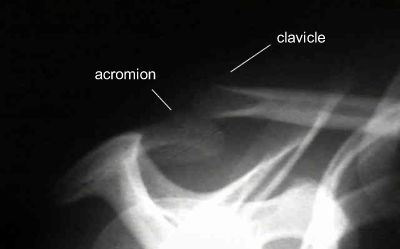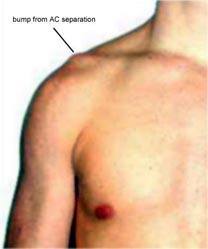The acromioclavicular (AC) joint is located at the end of the clavicle (collar bone) toward the shoulder. It is where the clavicle meets a part of the scapula called the acromion. When this joint is disrupted, it is called a shoulder separation (also called an acromioclavicular joint separation, or AC separation). This joint may also become arthritic due to previous injury, the aging process, or other conditions.

Figure 1. The acromioclavicular (AC) joint may be felt at the end of the collar bone.
Shoulder Separation
A shoulder separation is almost always the result of a sudden, traumatic event. This is often due to either a direct blow to the shoulder (often seen in football, rugby, or hockey), or a fall on to an outstretched hand (commonly seen after falling off a bicycle). Pain is the most common symptom of a separated shoulder, and is usually severe at the time of injury. If the injury is more severe a bump caused by the separated joint may be seen or felt at the tip of the shoulder bones.
Shoulder separation is often diagnosed quite readily from the history of the traumatic event, along with physical examination findings. An x-ray should be performed to ensure there is no fracture of these bones. If the diagnosis is unclear, an x-ray taken while the patient holds a weight in his or her hand may be helpful. When this type of x-ray is taken, the force of the weight will exagerate any shoulder joint instability and better show the deformity of the separated shoulder.
Treatment of a separated shoulder depends on the severity of the injury. The initial treatment of a separated shoulder consists of controlling the inflammation, and resting the joint. This can be done for the first several days until the swelling around the joint has subsided. Anti-inflammatory medication such as Advil or Motrin will also help to minimize the pain and inflammation–check with your doctor before using these medications. A sling to rest the shoulder joint may be worn until the pain has subsided enough to begin physical therapy exercises. Only in rare circumstances and severe injuries will surgery be needed to correct an AC joint disruption.

Figure 2. An AC joint separation. Normally the clavicle and the acromion line up with one another. Note that in this picture they do not.

Figure 3. A bump can be seen on this patient who has an AC joint separation.
AC Joint Arthritis
Arthritis of the AC joint may be a source of significant pain. This condition may result from previous injury, the natural “wear and tear” that occurs with aging, or from other conditions. As the joint wears out, the ends of the clavicle and acromion bones may rub together, causing pain. Bone spurs may also develop, causing pressure on the muscles underneath.
If this condition becomes severe enough, a surgery may be necessary in order to relieve the pain. The procedure usually involves removing the distal end of the clavicle (about 1 cm of bone is removed). This may be done directly through a small incision, or with an arthroscope.




